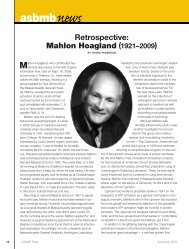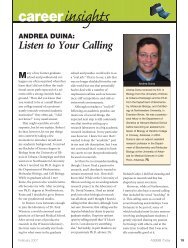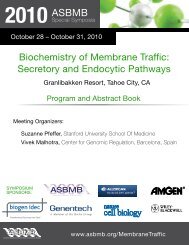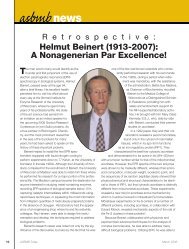asbmbnews
asbmbnews
asbmbnews
You also want an ePaper? Increase the reach of your titles
YUMPU automatically turns print PDFs into web optimized ePapers that Google loves.
fication conversely is a typical event; molecules are modified<br />
and remodified in continuous succession throughout the cell<br />
as a normal aspect of metabolism.<br />
Detection of these fatty-acid products must consider<br />
their small proportion among free fatty acids while also<br />
accounting for the bioavailable pools that already are<br />
adducted to proteins. The reversible electrophilicity of these<br />
molecules has been exploited as an analytical methodology<br />
designed to take advantage of their intrinsic properties.<br />
To distinguish electron-rich fatty acids from oxidized or<br />
nitrated electrophilic species, simple methods for exposing<br />
the analyte to competing thiol-containing nucleophiles<br />
have been developed. Then trans-alkylation to low molecular<br />
weight or immobilized nucleophiles permits capture of<br />
electrophilic species that are either free or already adducted<br />
via Michael addition to GSH or nucleophilic amino acids of<br />
proteins. In this regard, β-mercaptoethanol serves as an<br />
effective electrophile trapping agent. After chromatographically<br />
separating β-mercaptoethanol-adducted electrophiles,<br />
these adducts can be identified and analyzed by lossof-mass<br />
observations as they are cleaved under ionizing<br />
mass-spectrometric conditions. Through this methodology,<br />
new nitrated and oxidized fatty acid species are being<br />
detected in both animal models and clinically (1, 2).<br />
Why are electrophilic fatty acids relevant in biology?<br />
Multiple transcriptional regulation events and nuclear lipid<br />
receptors such as PPARγ are potently modulated by these<br />
species, resulting in predominantly anti-inflammatory and<br />
beneficial gene expression and metabolic responses (3).<br />
One can envision that the redox-dependent generation of<br />
electrophilic lipid products thus links gene expression to<br />
the metabolic and inflammatory status of tissues.<br />
Steven R. Woodcock (srw22@pitt.<br />
edu) is an instructor and Bruce A.<br />
Freeman (freerad@pitt.edu) the Irwin<br />
Fridovich professor and chairman<br />
of pharmacology and chemical<br />
biology at the University of Pittsburgh School of Medicine.<br />
REFERENCES<br />
1. Groeger A. L., Cipollina, C., Cole, M. P., Woodcock, S. R., Bonacci, G.,<br />
Rudolph, T. K., et al. Cyclooxygenase-2 generates anti-inflammatory mediators<br />
from omega-3 fatty acids. (2010) Nat. Chem. Biol. 6, 433 – 441.<br />
2. Schopfer, F. J., Batthyany, C., Baker, P. R., Bonacci, G., Cole, M. P., Rudolph,<br />
V., et al. Detection and quantification of protein adduction by electrophilic fatty<br />
acids: mitochondrial generation of fatty acid nitroalkene derivatives. (2009) Free<br />
Radic. Biol. Med. 46, 1250 – 1259.<br />
3. Rudolph, T. K., Freeman, B. A. Transduction of redox signaling by electrophileprotein<br />
reactions. (2009) Science Signaling. 2 (90) re7.






